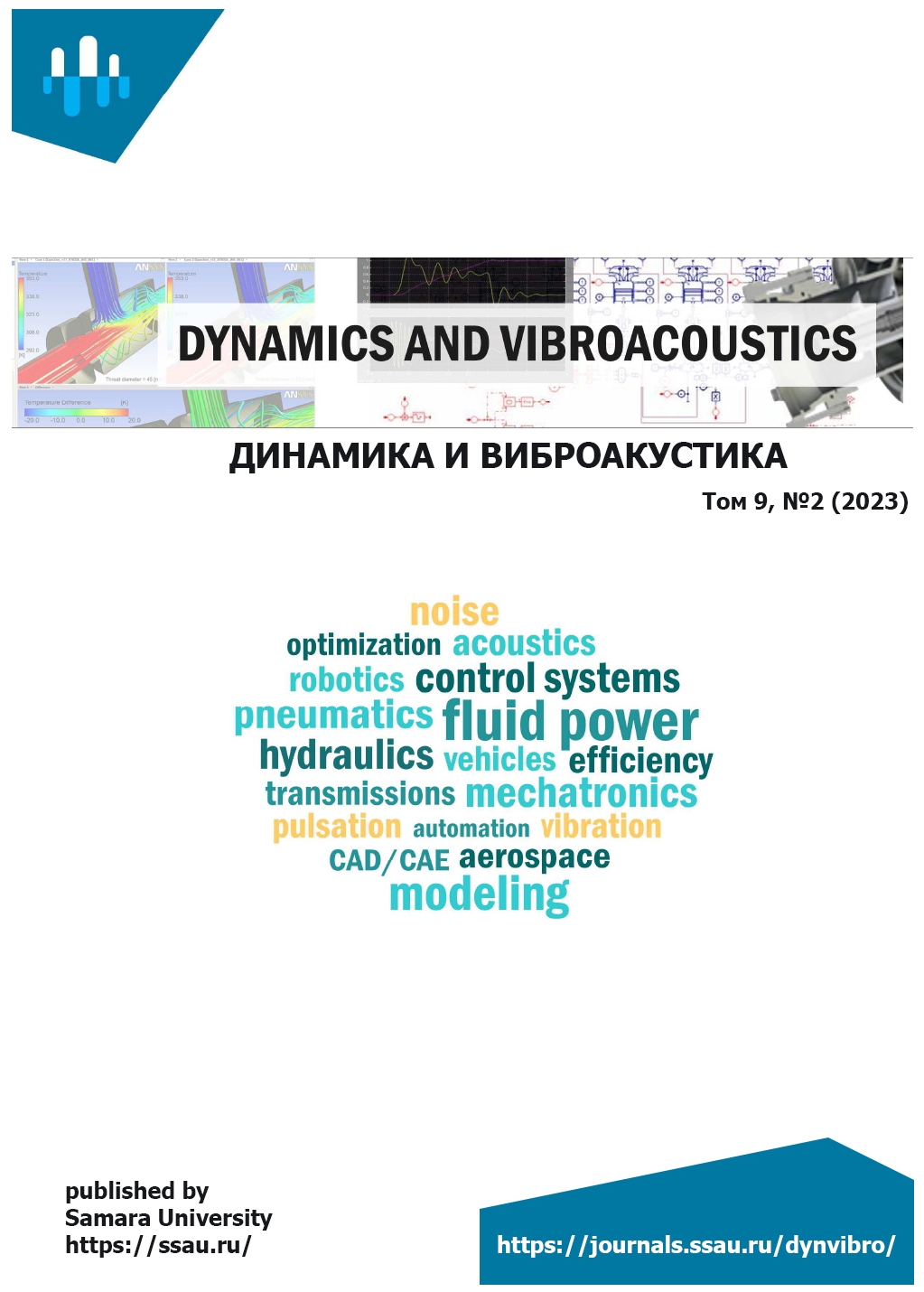Vol 9, No 2 (2023): 24.11.2023
- Year: 2023
- Published: 24.11.2023
- Articles: 5
- URL: https://dynvibro.ru/dynvibro/issue/view/625
-
Description:
опубликован 24.11.2023 г.
Full Issue
Articles
DETERMINATION OF THE CAPACITY OF THE EXHAUST NOISE MUFFLER OF PNEUMATIC SYSTEMS BY COMPUTATIONAL AND EXPERIMENTAL METHODS
Abstract
One of the main problems of pneumatic systems is the noise that occurs when compressed air is discharged, which negatively affects personnel. To create an effective noise muffler, it is necessary to predict its throughput. The article presents the results of experimental studies of the bandwidth of a noise muffler using porous polypropylene. A simulation model of a noise muffler as part of a pneumatic system has been created and calculations of pressure changes at control points have been carried out. Noise measurements were carried out and the acoustic efficiency of the developed muffler was determined, which amounted to 34.3 dBС and 32.4 dBА.
 6-12
6-12


EFFECTS OF WEAR AND FLANK CLEARANCE ON VIBRATION BEHAVIOR OF GAS TURBINE ENGINE GEARBOX
Abstract
The key defect of aircraft gas turbine engine gearboxes is the tooth flank wear and the corresponding increase in the flank clearance. The main danger of tooth wear is vibration generation resulting in fatigue failures of the engine structural elements. Using the example of tooth harmonics in the re-mating of teeth of the “sun gear – satellite” pair with frequency fZ1 and its sub harmonics with frequencies equal to one third and two thirds of it, as well as the vibration component that causes fatigue failures of engine structural elements, the change in the vibration state of the engine with the development of defects is shown. The sensitivity of the components under consideration to such defects is assessed. The potential danger of the component equal to two thirds of the tooth harmonics is revealed.
 13-17
13-17


NUMERICAL SIMULATION OF THE DYNAMIC BEHAVIOR OF A STRUCTURALLY SIMILAR SAMPLE FROM POLYMER COMPOSITE MATERIAL
Abstract
In this paper, the fatigue strength of a structural similar sample made of polymer composite material (PCM) is evaluated. Fatigue tests of structurally similar samples from PCM were carried out using an electrodynamic vibration stand. Based on the test results, a fatigue curve is constructed. A design model of a structurally similar sample has been developed, taking into account the design features and fixing the sample in the tooling during testing. In the future, it is planned to use the obtained computational model to study a structurally similar sample with a bundle obtained during testing and transfer the results to a full-size model.
 18-24
18-24


EFFICIENCY IMPROVEMENT OF MAGNETORHEOLOGICAL VALVE THROUGH GEOMETRIC PARAMETER VARIATION OF TECHNOLOGICAL GAP
Abstract
The use of magnetorheological fluid as a working fluid is an effective solution in terms of vibration protection and accuracy of drive movement. The magnetorheological drive is capable of moving an object weighing up to 100 kg with a movement error of 50 nm. The main control element of the drive is the magnetorheological valve. The magnetic field created in the process gap is a key characteristic of the valve. The study of the magnetic field induction in the technological gap of the inductor using the finite element method made it possible to determine the best combination of geometric parameters of the magnetic field concentrators (teeth) in terms of the maximum magnetic induction in the gap, which amounted to 1.4 Tesla. Increasing the induction in the gap will improve the efficiency of fluid flow control by the throttle, as well as the accuracy and speed of the drive.
 25-33
25-33


FEATURES OF OIL CONSUMPTION MEASUREMENT DURING BENCH TESTS OF INDUSTRIAL GAS TURBINE
Abstract
Oil consumption is one of the main operating parameters of a gas turbine engine. The article deals with the problems associated with determining oil consumption during bench tests of gas turbine drives. The required measurement error of no more than 0.1 kg/h is difficult to achieve with a bench oil system volume of about 200 liters and high thermal inertia. Therefore, the article proposes, in order to save fuel, to exclude special tests to determine oil consumption from the bench acceptance test program and transfer them to the acceptance tests of the engine as part of the gas pumping unit.
 34-38
34-38











